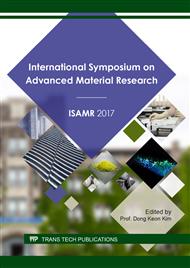[1]
C. Ren, Study on effect of cement grinding aid and complex grinding aid, (in Chinese). Guangdong Build. Meter. 8 (2010) 35.
Google Scholar
[2]
K. Z. Zhu, H. C. Chen, Z. Y. Xia, et al. Development status and trend of cement grinding aids at home and abroad, (in Chinese). China Cem. 3 (2010) 64-66.
Google Scholar
[3]
Cement grinding aid (GB/T26748-2011) (in Chinese).
Google Scholar
[4]
J. Q. Lu, X. Y. Wang, C. P. Wu, et al. Study on the modified cement grinding aids in the cement production, (in Chinese). 21st Century Build. Mater. 2(2) (2010) 19.
Google Scholar
[5]
H. Y. Zhao, Application technology of cement grinding aids (in Chinese). Chen xinzhong, Song nanjing. Beijing: Chemical Industry Publishing House. (2010).
Google Scholar
[6]
S. L. Chen, Guide for application of cement grinding aids, (in Chinese). Beijing: China Building Materials Industry Publishing House. (2014).
Google Scholar
[7]
S. L. Sun, X. F. Sun, Y. Xin, et al. Study on AF cement composite grinding aids (in Chinese). Cem. (7) (1997) 4-7.
Google Scholar
[8]
H. T. He, W. G. Li, Cement Grinding Aid Research and Application, (in Chinese). Cem. Technol. 20(1) (2007) 30-31.
Google Scholar
[9]
S. B. Ding, Y. M. Lin, H. J. Xiang, et al. Study on the development of cement grinding aids, (in Chinese). Cem. Guide New Epoch, (4) (2003) 26-28.
Google Scholar
[10]
Z. D. Tao, W. Zhao, Research on improving grinding efficiency and cement property by adding cement composite grinding aids, (in Chinese). J. Shandong Inst. Build. Mater. 8(2) (1994) 11-14.
Google Scholar
[11]
I. Aiad, A. A. Mohammed, S. A. Abo-El-Enein, Rheological Properties of Cement Pastes Admixed with Some Alkanolamines, Cem. Concr. Res. 33(1) (2003) 9-13.
DOI: 10.1016/s0008-8846(02)00911-0
Google Scholar
[12]
K. L. Ouyang, Evaluation of the grinding effect of alkanolamines and its influence on a lite hydration, (in Chinese). Zguangzhou. South China University of Technology, (2010).
Google Scholar
[13]
Teoreanu, G. Guslicov. Chemical and structural-mechanical studies on hardening behavirour of Portland cement with dihydroxy-ether compounds as grinding additives, Cement Sub-Committee of the Chinese Ceramic Society. Proceedings of the Beijing International Symposium on Cement and Concrete. Beijing, China Academic Journal Electronic Publishing House, (1998).
DOI: 10.1016/s0008-8846(98)00180-x
Google Scholar
[14]
J. S. Paul C. J. Sandberg, F. Doncaster, On the mechanism of strength enhancement of cement paste and mortar with triisopropanolamine, Cem. Concr. Res. 34(6) (2004) 973-976.
DOI: 10.1016/j.cemconres.2003.11.018
Google Scholar
[15]
C. J. Shi, H. Liu, P. L. Li, Effects of Triisopropanolamine on Hydration and Microstructure of Portland Limestone Cement, (in Chinese). J. Chin. Ceram. Soc. 39(10) (2011) 1673-1680.
Google Scholar
[16]
S. Aggoun, Z. O. Cheikh, M. Zouaoui, N. Chikh, Effect of some ad- mixtures on the setting time and strength evolution of cement pastes at early ages, Construct. Build. Mater. 22(2) (2008) 106.
DOI: 10.1016/j.conbuildmat.2006.05.043
Google Scholar
[17]
X. M. Kong, Z. B. Lu, Y. R. Zhang et al. Effect of Organic Grinding Aids on Cement Properties and the Analysis via Organic Cement Chemistry, J. Chin. Ceram. Soc. 40(1) (2012) 49-55.
Google Scholar
[18]
W. Zhang, X. J. Li, T. S. He, Effect of single component grinding aids on the properties of cement, (in Chinese). Cem. 9 (2009) 8-11.
Google Scholar
[19]
B. G. Ma, Y. X. Li, Application and research of grinding aid in the preparation of slag fine powder, (in Chinese). Cem. Eng. 5 (1999) 12-14.
Google Scholar
[20]
T. A. Ali, Investigation of the effects of fatty acids on the compressive strength of the concrete and the grind ability of the cement, Cem. Concr. Res. 35(2) (2005) 400-404.
Google Scholar
[21]
A. T. Albayrak, M. Yasar, M. A. Gurkaynak, The effects of faty acids on the particle size distribution of the Portland cement, J. Mater. Sci. 42(13) (2007) 5170.
DOI: 10.1007/s10853-006-0566-x
Google Scholar
[22]
S. Shang, T. L. Zhang, F. S. Yin, et al. The adsorption behavior of surfactant on the surface of Portland cement, (in Chinese). Deterg. Cosmet. 2000, S2.
Google Scholar
[23]
Z. Heren, H. mez, The influence of ethanolamines on the surface properties of Portland cement pastes, Cem. Concr. Res. 27(6) (1997) 805.
DOI: 10.1016/s0008-8846(97)00080-x
Google Scholar
[24]
W. Zhou, J. Q. Zhu, W. B. Zhou, et al. Effect of Triethanolamine and Triisopropanolamine on Hydration Process of Slag Cement, (in Chinese). Bull. Chin. Ceram. Soc. 32(1) (2013) 66-70.
Google Scholar
[25]
Y. Wang, Y. J. Wang, Z. Y. Zhang, et al. Effect of Different Organic Group on Cement Grinding Process (in Chinese). Bull. Chin. Ceram. Soc. 2009, 03.
Google Scholar


